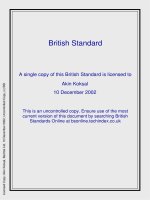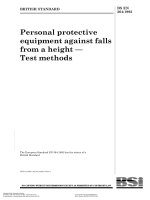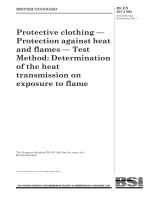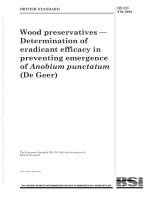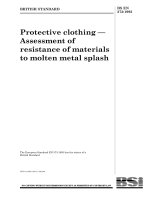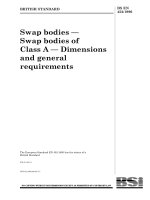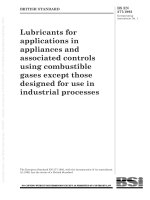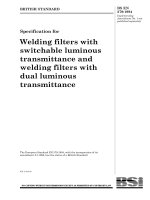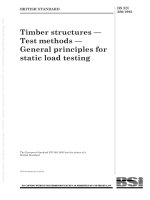Bsi bs en 61063 1996 (1999)
Bạn đang xem bản rút gọn của tài liệu. Xem và tải ngay bản đầy đủ của tài liệu tại đây (492.64 KB, 22 trang )
BRITISH STANDARD
Acoustics —
Measurement of
airborne noise emitted
by steam turbines and
driven machinery
The European Standard EN 61063:1996 has the status of a
British Standard
ICS 17.140.20; 27.040
BS EN
61063:1996
IEC 1063:1991
BS EN 61063:1996
Committees responsible for this
British Standard
The preparation of this British Standard was entrusted to Technical
Committee MCE/13, Steam turbines, upon which the following bodies were
represented:
Association of Consulting Engineers
Electricity Supply Industry in England and Wales
North of Scotland Hydro-electric Board
Power Generation Association (BEAMA Ltd.)
South of Scotland Electricity Board
This British Standard, having
been prepared under the
direction of the Engineering
Sector Board, was published
under the authority of the
Standards Board and comes
into effect on
15 July 1996
© BSI 10-1999
The following BSI references
relate to the work on this
standard:
Committee reference MCE/13
Draft for comment 87/75408 DC
ISBN 0 580 25677 4
Amendments issued since publication
Amd. No.
Date
Comments
BS EN 61063:1996
Contents
Committees responsible
National foreword
Foreword
Text of EN 61063
List of references
© BSI 10-1999
Page
Inside front cover
ii
2
3
Inside back cover
i
BS EN 61063:1996
National foreword
This British Standard has been prepared by Technical Committee MCE/13 and is
the English language version of EN 61063:1996 Acoustics — Test code for the
measurement of airborne noise emitted by steam turbines and driven machinery
published by the European Committee for Electrotechnical Standardization
(CENELEC). It is identical with IEC 1063:1991 published by the International
Electrotechnical Commission (IEC).
For graphical symbols, and letter symbols and signs approved by the IEC for
general use, readers are referred to:
— IEC Publication 27: Letter symbols to be used in electrical technology
— IEC Publication 617: Graphical symbols for diagrams
The symbols and signs contained in the present publication have either been
taken from IEC Publication 27 or 617, or been specifically approved for the
purpose of this publication.
For general terminology, readers are referred to IEC Publication 50:
International Electrotechnical Vocabulary (IEV), which is issued in the form of
separate chapters each dealing with a specific field, the General Index being
published as a separate booklet. Full details of the IEV will be supplied on
request1).
The terms and definitions contained in the present publication have either been
taken from the IEC or have been specifically approved for the purpose of this
publication.
Some Sections and Parts of BS 4727 are identical with or technically equivalent
to IEC Publication 50. All Parts of BS 3939, except for Part 1, are identical with
IEC Publication 617.
EN 61063 was produced as a result of international discussion in which the
United Kingdom took an active part.
Cross-references
Publication referred to
Corresponding British Standard
IEC 50(801):1984
BS 4727 Glossary of electrotechnical, power,
telecommunication, electronics, lighting and colour
terms
Part 3 Terms particular to telecommunications and
electronics
Group 08:1995 Acoustics and electroacoustics
BS 6840 Sound system equipment
Part 4:1987 Methods for specifying and measuring
the characteristics of microphones
BS EN 60651:1994 Specification for sound level
meters
BS 4196 Sound power levels of noise sources
Part 0:1981 Guide for the use of basic standards and
for the preparation of noise test codes
BS EN ISO 3744:1995 Acoustics. Determination of
sound power levels of noise sources using sound
pressure.
Engineering method in essentially free-field over a
reflecting plane
IEC 268-4:1972
EN 60651:1994
(IEC 651:1979)
ISO 3740:1980
ISO 3744:1981b
a
a
IEC 50(801):1984 has been superseded by IEC 50(801):1994 with which the British Standard cited
is identical.
b
ISO 3744:1981 has been superseded by ISO 3744:1994 with which the British Standard cited is
identical.
1)
Available from BSI, Customer Services, Sales Department, 389 Chiswick High Road, London
W4 4AL.
ii
© BSI 10-1999
BS EN 61063:1996
ISO 3746:1979
BS 4196 Sound power levels of noise sources
Part 6:1981 Survey method for determination of
sound power levels of noise sources
A British Standard does not purport to include all the necessary provisions of a
contract. Users of British Standards are responsible for their correct application.
Compliance with a British Standard does not of itself confer immunity
from legal obligations.
Summary of pages
This document comprises a front cover, an inside front cover, pages i to iv,
the EN title page, pages 2 to 14, an inside back cover and a back cover.
This standard has been updated (see copyright date) and may have had
amendments incorporated. This will be indicated in the amendment table on the
inside front cover.
© BSI 10-1999
iii
iv
blank
EUROPEAN STANDARD
EN 61063
NORME EUROPÉENNE
January 1996
EUROPÄISCHE NORM
ICS 17.140.20
Descriptors: Acoustics, acoustic measurement, acoustic test, machine noise, air noise, turbine, environment, acoustic pressure, level,
calculation
English version
Acoustics
Measurement of airborne noise emitted by steam turbines
and driven machinery
(IEC 1063:1991)
Acoustique
Mesure de bruit aérien émis par les turbines à
vapeur et les machines entrnées
(CEI 1063:1991)
Akustik
Messung von luftübertragenen Geräuschen
emittiert von Dampfturbinen und
angetriebenen Maschinen
(IEC 1063:1991)
This European Standard was approved by CENELEC on 1995-05-15.
CENELEC members are bound to comply with the CEN/CENELEC Internal
Regulations which stipulate the conditions for giving this European Standard
the status of a national standard without any alteration.
Up-to-date lists and bibliographical references concerning such national
standards may be obtained on application to the Central Secretariat or to any
CENELEC member.
This European Standard exists in three official versions (English, French,
German). A version in any other language made by translation under the
responsibility of a CENELEC member into its own language and notified to the
Central Secretariat has the same status as the official versions.
CENELEC members are the national electrotechnical committees of Austria,
Belgium, Denmark, Finland, France, Germany, Greece, Iceland, Ireland, Italy,
Luxembourg, Netherlands, Norway, Portugal, Spain, Sweden, Switzerland and
United Kingdom.
CENELEC
European Committee for Electrotechnical Standardization
Comité Européen de Normalisation Electrotechnique
Europäisches Komitee für Elektrotechnische Normung
Central Secretariat: rue de Stassart 35, B-1050 Brussels
© 1996 Copyright reserved to CENELEC members
Ref. No. EN 61063:1996 E
EN 61063:1996
Foreword
The text of the International Standard
IEC 1063:1991, prepared by IEC TC 5, Steam
turbines, was submitted to the formal vote and was
approved by CENELEC as EN 61063 on 1995-05-15
without any modification.
The following dates were fixed:
Contents
Foreword
Introduction
1 Scope
2 Normative references
3 Definitions
— latest date by which the
4 Acoustic environment
EN has to be implemented
at national level by
5 Instrumentation
publication of an identical
6 Installation and operation of
national standard or by
turbine set
endorsement
(dop) 1996-07-01
7 Measurement of A-weighted sound
— latest date by which the
pressure level
national standards
8 Calculation of surface sound pressure
conflicting with the EN
level and sound power level
have to be withdrawn
(dow) 1996-07-01
9 Information to be recorded
Annexes designated “normative” are part of the
10 Information to be reported
body of the standard. In this standard, Annex A
Annex A (normative) Test environment
and Annex ZA are normative. Annex ZA has been
qualification procedure
added by CENELEC.
Annex ZA (normative) Normative references
to international publications with their
corresponding European publications
Figure 1 — General situation of the turbine
sets, including their ancillaries and
auxiliaries
Figure 2 — Typical arrangements of
microphone positions
Figure A.3 — Environmental correction K,
in decibels
Table 1 — Uncertainty in determining
A-weighted sound power level by the survey
method
Table 2 — Correction for background noise
2
Page
2
3
3
4
5
5
6
6
6
8
9
10
11
14
3
7
12
4
8
© BSI 10-1999
EN 61063:1996
Introduction
This standard is based on ISO 3746 and has been drafted in accordance with ISO 3740.
The main purpose of this standard is to describe a method for the measurement of noise radiated by
steam-turbines including driven machinery operating under steady state conditions. The results are
expressed in sound power levels and in sound pressure levels.
NOTE For special environmental conditions, it may be possible to use the engineering methods based on ISO 3744 resulting in a
higher grade of accuracy. In this case no reference to this standard will be made.
1 Scope
1.1 General
1.1.1 This International Standard applies to the measurement of airborne noise emitted by assemblies
comprising steam turbines and driven machinery, hereinafter referred to as turbine sets. These sets are of
all sizes without limitation of output when fitted with their normal auxiliaries. This standard applies only
to the part of the turbine set (turbine, generator and attached components) located above the floor of the
turbine room and inside a continuous enveloping measurement surface bounded by this floor.
An extensive and continuous turbine operating floor of a reflecting nature above the turbine foundation
floor level shall be considered as the reflecting plane.
1.1.2 In the case of large turbine sets, the turbine operating floor is often located below and near the
horizontal centreline of the turbine (see Figure 1). If this floor is continuous and free from openings which
would otherwise allow noise radiated below the turbine operating floor to influence the noise measured at
microphone locations, a valid measure of the turbine set noise emission may be obtained by use of this
standard.
Figure 1 — General situation of the turbine sets, including their ancillaries and auxiliaries
1.1.3 In the case where the turbine operating floor is located below and near the horizontal centerline of
the turbine set, but consists of:
a) an open grating construction, or
b) a solid floor with openings near to the boundary of the turbine set, or
c) walkways typically 1 to 2 m wide of either solid or grated construction,
the turbine operating floor cannot be considered as a reflecting plane. In this case the reflecting plane will
be the turbine set foundation floor.
© BSI 10-1999
3
EN 61063:1996
In the case of the continuous enveloping measurement surface being bounded by either the turbine
operating floor or the turbine foundation floor, a large contribution from the noise of ancillary and auxiliary
plant located below the turbine operating floor may be expected at the microphone measuring positions. In
this case the use of this standard for the determination of sound power levels is not valid.
If this standard is to be employed for the purpose of the comparison of the 1 m sound levels of similar
turbines, the turbine operating floor shall be used as the bounding surface for the continuous enveloping
measurement surface. The validity of comparative measurements will depend on the noise present at the
measurement positions due to auxiliary and ancillary plant and it will be necessary to define exactly the
number, type and location of these items.
It is preferable to establish the effect auxiliary and ancillary plant noise radiation will have on the sound
level at the microphone locations by determining the noise emission of these items in accordance with
ISO 3746, and determining the propagation of this noise to microphone locations. However, this procedure
is beyond the scope of this standard.
NOTE When openings in the floor are suitably blocked during the test with appropriate panels (upper side of panels should have
same reflective characteristics as the turbine operating floor), valid measurements are permitted.
1.1.4 In the case of turbine sets mounted on, or partially submerged in, the foundation floor, which may
also be defined as the turbine operating floor, a valid measure of the turbine set noise emission may be
obtained by use of this standard.
1.1.5 Where noise control treatments such as enclosures and/or screens are fitted to the turbine set, driven
equipment and auxiliaries, the type, location and extent of treatment shall be reported.
1.2 Measurement uncertainty
Measurements made in conformity with this standard tend to result in standard deviations which are equal
to or less than those given in Table 1.
Table 1 — Uncertainty in determining A-weighted sound power level by the survey method
Standard deviation
dB
Application
For a source which produces sounds that contain prominent discrete tones
5
For a source which produces sounds that are uniformly distributed in
frequency over the frequency range of interest
4
NOTE 1 If the method specified in this standard is used to compare the sound power levels of similar machines that are
omnidirectional and radiate broad band noise, the uncertainty in this comparison tends to result in a standard deviation which is
equal to or less than 3 dB provided that the measurements are performed in similar environments.
NOTE 2 The standard deviations given in this table reflect the cumulative effects of all causes of measurement uncertainty,
excluding variations in the sound power level from machine to machine or from test to test which may be caused, for example, by
changes in the mounting or operating conditions of the source. The reproducibility and repeatability of the test results may be
considerably better (i.e. indicate smaller deviations) than the uncertainties given in Table 1 would indicate.
NOTE 3 The standard deviations given above are considered, in the light of the experimental evidence available, to be conservative.
2 Normative references
The following standards contain provisions which, through reference in this text, constitute provisions of
this International Standard. At the time of publication, the editions indicated were valid. All standards are
subject to revision, and parties to agreements based on this International Standard are encouraged to
investigate the possibility of applying the most recent editions of the standards indicated below. Members
of IEC and ISO maintain registers of currently valid International Standards.
IEC 50(801):1984, International Electrotechnical Vocabulary (IEV) Chapter 801: Acoustics and
electro-acoustics.
IEC 268-4:1972, Sound-system equipment — Part 4: Microphones.
IEC 651:1979, Sound level meters.
ISO 3740:1980, Acoustics — Determination of sound power levels of noise sources — Guidelines for the use
of basic standards and for the preparation of noise test codes.
ISO 3744:1981, Acoustics — Determination of sound power levels of noise sources — Engineering methods
for free-field conditions over a reflecting plane.
ISO 3746:1979, Acoustics — Determination of sound power levels of noise sources — Survey method.
4
© BSI 10-1999
EN 61063:1996
ISO 6926-2, Acoustics — Determination of sound power levels of noise sources — Requirements for the
performances and calibration of reference sound sources. (In preparation.)
3 Definitions
For the purpose of this International Standard the following definitions apply:
3.1
sound pressure level, Lp, in decibels
twenty times the logarithm to the base 10 of the ratio of the sound pressure to the reference sound
pressure. The weighting network used shall be indicated: for example, A-weighted sound pressure level,
LpA. The reference sound pressure is 20 4Pa
3.2
A-weighted surface sound pressure level, L pA , in decibels
the A-weighted sound pressure level averaged over the measurement surface as required in clause 8
3.3
sound power level, LW, in decibels
ten times the logarithm to the base 10 of the ratio of a given sound power to the reference sound power. The
weighting network used shall be indicated: for example, A-weighted sound power level, LWA. The reference
sound power is 1 pW (10–12W)
3.4
measurement surface
a hypothetical surface of area S enveloping the source on which the microphone positions are located
3.5
reference surface
a hypothetical surface which is the smallest rectangular parallelepiped (i.e., rectangular box) that just
encloses the source and terminates on the reflecting plane
3.6
measurement distance
the distance between the reference surface and the measurement surface
3.7
background noise
the A-weighted sound pressure level at each microphone position with the primary sound source
inoperative
4 Acoustic environment
4.1 Criteria of adequacy of the test environment
Ideally, the test environment should be free from reflecting objects other than a reflecting plane so that the
source radiates into a free-field over a reflecting plane. Test environments which are suitable for
measurements according to this standard include a flat outdoor area and a room which meets the
qualification requirements of Annex A.
Annex A describes procedures for determining the magnitude of the environmental correction (if any) to
account for deviations of the test environment from the ideal conditions.
NOTE If it is necessary to make measurements in spaces which do not meet the criteria of Annex A, the standard deviation of the
test results may be greater than the one given in 1.2.
4.2 Criterion for background noise level
At the microphone positions the A-weighted sound pressure level due to background noise should be at
least 3 dB below the A-weighted sound pressure level with the primary source operating.
NOTE When the sound pressure level of the primary source is less than 3 dB above the background sound pressure level, a valid
measurement of the machine under test cannot be made. However, the result determined with higher background sound level may
be useful as an indication of the upper limit of the sound power level of the source.
© BSI 10-1999
5
EN 61063:1996
4.3 Wind
If measurements are to be made outdoors, the wind speed shall be less than 6 m/s. A windscreen should be
used for wind speeds above 1 m/s to ensure that the level of the background noise (caused by the cumulative
effect of the wind and the other background noise sources) is at least 3 dB below the level with the source
operating.
5 Instrumentation
5.1 General
A sound level meter that meets the requirements of IEC 651 shall be used with the “slow” time weighting.
To minimize the influence of the observer on the measurements, a cable or an extension rod should be used
between the microphone and the sound level meter. The observer shall not stand between the microphone
and the source whose sound power level is being determined.
5.2 Calibration
At least before each series of measurements, an acoustical calibrator with an accuracy of ± 0,5 dB shall be
applied to the microphone for checking the calibration of the entire measuring system, including cable if
used, at one or more frequencies. One calibration frequency shall be in the range of 250 to 1 000 Hz. The
calibrator shall be checked annually to verify that its output has not changed.
6 Installation and operation of turbine set
6.1 Mounting of turbine set
Normally, measurements will be performed on site, at the completely mounted turbine set fitted with all
insulations and lagging.
NOTE Results of noise measurements in field tests, as far as test runs can be performed there, can only be utilized if they have not
been affected by additional unavoidable noise, emitted by mounting devices, drive, load and other field test equipment.
6.2 Operation of turbine set during test
The turbine set should operate normally under its rated load(s), speed(s) and excitation condition(s). It may
be useful to repeat the measurements under all typical sustained load conditions, for example
at 25 %, 50 %, 75 % and 100 % of the rated load, in order to be sure of characterizing the noisiest operating
conditions.
The turbine set shall be in a steady state operating condition before any sound measurements are made.
Care should be taken to avoid noise coming from other machines (see 6.3 and 7.3).
NOTE During start up and shut down, higher noise levels, produced by auxiliary equipment (e.g., drains, by-pass devices) and
emitted partly also by components of the turbine set, may occur for short periods. Such noise sources or operating conditions are not
covered by this standard.
6.3 Auxiliary equipment and coupled machines
All auxiliary equipment which is necessary for the operation of the turbine set under test, but not part of
it, shall not significantly influence the noise measurement (see 7.3).
7 Measurement of A-weighted sound pressure level
7.1 Reference surface and measurement surface
The relevant reference surface is composed of several separate reference boxes placed in juxtaposition so
that they enclose only the different parts of the turbine set, including its lagging and any noise control
screen and enclosures. The surface terminates on the reflecting plane. When defining the dimensions of
this reference surface, elements protruding from the source which are unlikely to be major radiators of
sound energy may be disregarded. This is generally the case only for valves and the reference surface will
enclose these protruding elements, if any. If valves are not part of the main body of the turbine set, separate
measurements should be made according to this standard. The construction of the reference surface and of
the measurement surface and the distribution of the microphone positions should be clearly described in
the measurement report.
NOTE To obtain equal measurement surfaces for similar turbine sets, the reference boxes are always defined according to a turbine
with its usual lagging, even if it is planned to operate it without lagging.
6
© BSI 10-1999
EN 61063:1996
The microphone positions lie on the measurement surface, a hypothetical surface of area S, which envelops
the source as well as the reference box(es) and terminates on the reflecting plane.
For turbine sets, regardless of their size, the measurement surface shape is composed of rectangular
parallelepipeds (see Figure 2), whose sides are parallel to the sides of the reference boxes spaced out at a
distance d (measurement distance) from the reference boxes. The measurement distance (d) is 1 m.
According to Figure 2, the area S of the measurement surface shall be calculated from:
(1)
where:
hmax is the maximum height
bmax is the maximum width
Z is the number of rectangular parallelepipeds
a) Turbine set with gear and compressor
b) Large turbine set with generator and exciter
X are the key microphone positions
O are the additional microphone positions
Figure 2 — Typical arrangements of microphone positions
© BSI 10-1999
7
EN 61063:1996
7.2 Microphone array
7.2.1 Key microphone positions on the measurement surface
Figure 2 prescribes the location of five key microphone positions.
7.2.2 Additional microphone positions on measurement surface
The number of additional microphone positions depends on the dimensions and on the number of different
parts of the complete turbine set. Beginning at the key microphone positions, additional positions are
arranged at equal distances. The distances are such that there is at least one measurement section at each
casing of the turbine set.
NOTE For safety or cost reasons, the overhead positions may be deleted, provided it can be shown by preliminary investigation that
the exclusion of the overhead position does not influence the calculated sound power level of the source by more than 1,0 dB.
Usually, a turbine is mounted on a foundation high above ground and some of its parts radiate noise into the room below the operating
floor. At these locations the noise often comes mainly from equipment which is not part of the turbine set. Because of this high
background noise no microphone positions for this area can be recommended. This area can be neglected for the determination of the
sound power level of the turbine set as its radiating surface in this area is small compared with the total surface of the turbine.
7.3 Measurement of A-weighted sound pressure levels
Following selection of the appropriate microphone locations on the rectangular array, the A-weighted
sound pressure levels are measured at each of the specified positions. After corrections are applied for
background noise (see 8.1), this data is used for the calculation of the surface sound pressure level and
sound power level according to clause 8.
7.4 Measurement conditions
Environmental conditions may have an adverse effect on the microphone used for the measurements. Such
conditions (e.g., strong electric or magnetic fields, wind, impingement of air or steam discharged from the
machine being tested, high or low temperatures) shall be avoided by proper selection of placement of the
microphone.
NOTE
For additional information, the user is referred to IEC 268-4 and IEC 651.
The sound pressure level shall be observed over a typical operating period of the machine. A-weighted
sound pressure levels (corresponding to the mean-square sound pressure level) shall be taken at each
measuring point. The instrumentation used shall comply with the requirements of clause 5.
The following data shall be obtained:
a) the A-weighted sound pressure levels during operation of the machine under test,
b) the A-weighted sound pressure levels of the background noise.
8 Calculation of surface sound pressure level and sound power level
8.1 Correction for background noise
The sound pressure levels recorded at each of the microphone positions shall be corrected for the influence
of background noise, according to Table 2.
Table 2 — Correction for background noise
Difference between sound pressure level measured with
sound source operating and background sound pressure
level alone
Correction to be subtracted from sound pressure level
measured with sound source operating to obtain sound
pressure level due to sound source alone
dB
dB
3
4
5
6
7
8
9
10
> 10
3
2
2
1
1
1
0,5
0,5
0,0
NOTE 1 In the majority of situations (especially for indoor measurements), it will be impossible to determine background sound
level without turbine operating. In these cases the background sound level may be only evaluated by computation, taking into account
the sound power level of the auxiliary plant and the reflection properties of the test room.
8
© BSI 10-1999
EN 61063:1996
NOTE 2 Another approach is to conduct a sound survey in order to identify the major background noise sources. Acoustical lagging
or a barrier could be applied, as appropriate, to reduce the background sound level.
8.2 Environmental correction
If necessary, the measured sound pressure levels shall be corrected for unwanted reflections present in the
test environment. Clause A.3 of Annex A gives the detailed procedure to be followed in determining the
magnitude of the correction K (in decibels).
8.3 Calculation of the A-weighted surface sound pressure level, L pA
The A-weighted surface sound pressure level, L pA , is calculated from the measured A-weighted sound
pressure levels LpAi (after corrections are applied according to 8.1, if necessary) by using the following
equation:
(2)
where:
L pA
is the A-weighted surface sound pressure level, in decibels Reference: 20 4Pa
LpAI
is the A-weighted sound pressure level in decibels at the ith measurement position Reference: 20 4Pa
N
is the total number of measurement positions
K
is the environmental correction to account for the influence of reflected sound, in decibels
The environmental correction K typically ranges from 0 dB (for measurements outdoors), to more
than 10 dB for measurements indoors in highly reverberant rooms. For the purpose of this standard, the
maximum allowable value of K is 7 dB.
NOTE When the range of values of LpAI does not exceed 5 dB, a simple arithmetic average may be used. This average should not
differ by more than 0,7 dB from the value using equation (2).
8.4 Calculation of the A-weighted sound power level, LWA
The A-weighted sound power level, LWA, shall be calculated from the equation:
LWA = L pA + 10 log10 (S/S0)
(3)
where:
LWA
is the A-weighted sound power level of the source, in decibels Reference: 1 pW
L pA
is the A-weighted surface sound pressure level in decibels, determined according to 8.3
Reference: 20 4Pa
S
is the area of the measurement surface in square metres
S0
= 1 m2
9 Information to be recorded
The following information, when applicable, shall be compiled and recorded for all measurements made in
accordance with this standard.
9.1 Turbine set under test
a) Description of the turbine set under test (including its dimensions).
b) Operating conditions.
c) Mounting conditions and location of the turbine operating floor in relation to the turbine set and the
foundation floor.
d) If the machine has multiple noise sources which are only temporarily operating source(s), description
of the source(s) in operation during measurements.
e) Number and location of auxiliary and ancillary plant noise sources likely to influence the noise at
microphone locations.
f) Number, type, location and extent of noise control screens and/or enclosures.
© BSI 10-1999
9
EN 61063:1996
9.2 Acoustic environment
a) Description of test environment:
If indoors, describe physical treatment of walls, ceiling and floor; include a sketch showing location of
source(s), all room contents and other important details, for example, openings in the floor.
If outdoors, include a sketch showing location of the source with respect to surrounding terrain,
including physical description of the test environment. The nature of the reflecting (ground) plane shall
be recorded.
b) Acoustical qualification of test environment according to Annex A.
9.3 Instrumentation
a) Equipment used for the measurements, including name, type, serial number and manufacturer.
b) Date and place of calibration of the instrumentation system.
c) Method used for checking the calibration of the microphones and other measurement equipment.
9.4 Acoustical data
a) The locations of the microphone positions (a sketch may be included, if necessary) and the
measurement distance.
b) The area(s) S of the measurement surface(s).
c) The A-weighted sound pressure levels at all microphone positions.
d) The A-weighted sound pressure levels of the background noise for each microphone position and the
corresponding correction.
e) The environmental correction K calculated according to Annex A.
f) The A-weighted surface sound pressure level.
g) The calculated A-weighted sound power level. The value shall be rounded to the nearest whole decibel.
h) Remarks on subjective impression of noise (audible discrete tones, impulsive character, spectral
content, temporal characteristics, etc.).
i) The date and time when the measurements were performed.
10 Information to be reported
The report shall contain the statement that the A-weighted sound power level has been obtained in full
conformity with the procedures of this standard and that this level is expressed in decibels
above 1 pW (10–12 W).
Only data (see clause 9) need be reported which is required by the ultimate user of the information.
The following minimum data shall be reported:
a) Description of the turbine under test, including the provision of noise control screens and/or
enclosures.
b) Operating conditions.
c) The A-weighted sound pressure levels at each microphone position all around the turbine set under
test, corrected for the background noise.
d) The A-weighted surface sound pressure level(s).
e) The A-weighted sound power level(s).
f) The date and time when the measurements were performed.
In special cases, for example performance tests, it might be necessary that the test report contains all
information listed under clause 9.
10
© BSI 10-1999
EN 61063:1996
Annex A (normative)
Test environment qualification procedure
A.1 General
An environment providing an approximately free field over a reflecting plane shall be used for
measurements made according to this standard. The environment may be provided by a suitable test area
outdoors or an ordinary room if the requirements given in this annex are satisfied.
With the exception of the reflecting plane, reflecting objects shall be removed to the maximum extent
possible from the vicinity of the machine under test. A test room shall ideally provide a hypothetical
measurement surface which lies:
a) inside a sound field essentially undisturbed by reflections from objects nearby and the room
boundaries, and,
b) outside the field near to the sound source under test.
For the purposes of this survey method at frequencies above 100 Hz, the measurement surface is
considered to lie outside the near field if the measurement distance from the source under test is equal to
or greater than 0,25 m.
For outdoor measurements, the prescribed conditions of clause A.2 shall be satisfied. For indoor
measurements, one of the alternative qualification procedures of clause A.3 shall be followed. Otherwise,
the measurements will not be in conformity with the requirements of this standard.
A.2 Environment conditions
A.2.1 Types of reflecting planes
For outdoor measurements, the reflecting plane should be undisturbed earth or an artificial surface of
concrete or sealed asphalt. For indoor measurements, the reflecting plane is usually the floor of the room.
NOTE When the reflecting surface is not a ground plane or the floor of the test room, care should be taken to ensure that the
reflecting surface does not radiate any appreciable sound energy due to vibrations.
A.2.1.1 Shape and size
The reflecting surface shall be larger than the projection of the measurement surface on it and preferably
extend to a distance greater than 4 m beyond it.
A.2.1.2 Sound absorption coefficient
The sound absorption coefficient of the reflecting plane should preferably be less than 0,1 over the
frequency range of interest. This requirement is usually fulfilled when outdoor measurements are made
over concrete sealed asphalt, sand or stone surfaces. For indoor measurements, wooden and tile floors are
permitted.
A.2.2 Reflecting objects
No reflecting objects that are not part of the sound source under test shall be located inside the
measurement surface.
A.2.3 Precautions for outdoor measurements
It should be realized that adverse meteorological conditions (for example, temperature gradients, wind
gradients, precipitation and humidity) may all affect the measurements. Extreme meteorological
conditions should be avoided during the measurements. In all cases, the precautions indicated by the
manufacturer in the instructions for the use of the instrument shall be observed.
A.3 Qualification procedure and requirements for test rooms
A.3.1 Test procedure
The environmental correction K in equation (2) of 8.3 accounts for the influence of undesired sound
reflections from room boundaries and/or reflecting objects near the source under test. The magnitude of this
environmental correction K depends principally on the ratio of the equivalent sound absorption area A of
the test room to the area S of the measurement surface. The magnitude is not notably dependent on the
location of the source in the test room.
In this standard, the environmental correction K is obtained from Figure A.3, given the appropriate value
of A/S. The area S of the measurement surface is calculated from equation (1) given in 7.1.
© BSI 10-1999
11
EN 61063:1996
Figure A.3 — Environmental correction K, in decibels
The equivalent sound absorption area is determined from the reverberation time measurement of the test
room which is excited by broad-band noise or an impulsive sound with A-weighting on the receiving system.
The value of A is given, in square metres, by the formula:
A = 0,16 (V/T)
where:
V
is the volume of the test room, in cubic metres
T
is the reverberation time for the test room, in seconds
A.3.2 Alternative test procedure based on the use of a reference sound source
The environmental correction K may be determined alternatively by calculating the sound power level of a
reference sound source which has previously been calibrated in a free field over a reflecting plane (K = 0).
In this case, K is given by the expression:
K = LW – LWr
where:
LW
is the sound power level, reference 1 pW, in decibels, of the reference sound source. This is determined according to the
procedures described in ISO 3746 without the environmental correction K (i.e., K is initially assumed to equal zero).
LWr
is the calibrated sound power level of the reference sound source, reference 1 pW, in decibels, which is determined
according to the procedure described in the future ISO 6926-2.
NOTE LW is the mean value of two determinations made in the middle of each longitudinal side of the turbine set under test with
the enveloping measurement surface placed at 1 m distance of the reference sound source. If the length of the machine under test is
greater than 10 m, two supplementary positions are to be used for the reference sound source, placed, if possible, at each extremity
of the machinery.
A.3.3 Qualification requirements for test rooms
For the measurement surface in a test room to be satisfactory for measurements according to the
requirements of this standard, the environmental correction K shall not exceed 7 dB.
Kk7
12
© BSI 10-1999
EN 61063:1996
It means that the ratio of the absorption area A to the area S of the measurement surface shall be equal to
or greater than 1:
A/S U 1
NOTE
The larger the ratio A/S, the better.
If the above requirements cannot be satisfied, the ratio A/S may be increased by introducing
sound-absorptive material into the test room and redetermining the value of the ratio A/S under the new
conditions.
If the requirements of this clause cannot be satisfied, the particular environment cannot be used for
measurements of the source under test according to the requirements of this standard.
A.4 Qualification requirements for measurements outdoors
For very large rooms in relation to the volume of the turbine set, and for workspaces which are not totally
enclosed, the value of the environmental correction K can be assumed to be equal to zero. For
measurements outdoors, the reflecting plane shall have properties defined in A.2.1 and the background
sound levels shall meet the requirements of 4.2.
© BSI 10-1999
13
EN 61063:1996
Annex ZA (normative)
Other international publications quoted in this standard with the references of
the relevant European publications
This European Standard incorporates by dated or undated reference, provisions from other publications.
These normative references are cited at the appropriate places in the text and the publications are listed
hereafter. For dated references, subsequent amendments to or revisions of any of these publications apply
to this European Standard only when incorporated in it by amendment or revision. For undated references
the latest edition of the publication referred to applies (including amendments).
NOTE When the international publication has been modified by CENELEC common modifications, indicated by (mod), the relevant
EN/HD applies.
Publication
Date
Title
EN/HD
Date
IEC 50(801)
1984
International Electrotechnical Vocabulary (IEV)
Chapter 801: Acoustics and electro-acoustics
—
—
IEC 268-4
1972
Sound system equipment
Part 4: Microphones
—
—
IEC 651
1979
Sound level meters
EN 60651 1994
ISO 3740
1980
Acoustics — Determination of sound power levels of
noise sources — Guidelines for the use of basic
standards and for the preparation of noise test codes
—
—
ISO 3744
1981
Acoustics — Determination of sound power levels of
noise sources — Engineering methods for free-field
conditions over a reflecting plane
—
—
ISO 3746
1979
Acoustics — Determination of sound power levels of
noise sources — Survey method
—
—
ISO 6926-2
—
Acoustics — Determination of sound power levels of
noise sources — Requirements for the performances
and calibration of reference sound sources
(in preparation)
—
—
14
© BSI 10-1999

